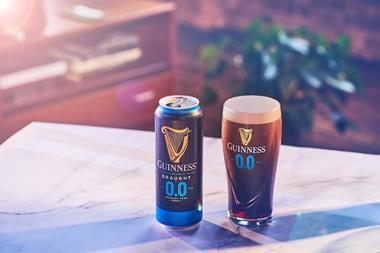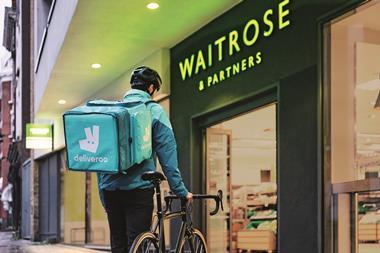Aldi has unveiled a bold new blueprint for a more upmarket offer, says James Durston
After a decade of near media silence, German hard discounter Aldi has finally spoken. Last week it invited The Grocer to the opening of its new store in Rugby, where it announced that it is spending £500m opening new stores and revamping existing ones in a bold bid to take on the likes of Tesco and Sainsbury with a more upmarket offer.
Tony Baines, managing director, group buying, is surprisingly candid about the retailer’s track record since entering the UK market back in 1990. “We have got things wrong,” he says. However, he adds, Aldi is confident that it can put the days of overly basic design, poor locations and doggedly Germanic branding behind it.
And the Rugby store is very much the blueprint for that metamorphosis, he says.
The store certainly looks very different from the usual Aldi. Located less than a mile from the local Tesco superstore, it is on the other side of town from an existing Aldi and in a slightly more affluent area. Gone is the dark, boxy exterior in favour of a fluid scheme built in a mixture of glass and aluminium.
Andreas Siegmann, regional managing director at Aldi, admits that Tesco customers are high on the Aldi target list and the new store has been designed with this C1/C2 customer demographic in mind. He says: “To date our stores have been functional and cost-efficient, but also a bit blunt. In our quest to conquer this new market better, we need to have a more relevant design.”
The changes are equally apparent inside the store. The stark white interior has been replaced with a warmer beige tone. Signage is much clearer. Sightlines have been dramatically improved by restricting taller shelving to the perimeter of the store, while lower shelving dominates the middle. Light suffuses the interior, thanks to extra windows.
The store layout is simple, efficient and easy to navigate, and these are the key concepts that will be driving developments from now on. Siegmann says: “The key is in the little details that each add up to help us keep our prices low. For instance, we have incorporated extended barcodes into the packaging of our own lines, and double scans at the till are now almost completely eliminated.”
This minimises delays and helps ensure there are never more than three people queuing at a time at any till.
Aldi has responded to demand for more fresh produce by increasing its range to 240 lines, up from 150 five years ago. And it is given much more prominence. Indeed, as soon as a customer enters the store, they will pass the fresh bread and flowers. The chiller cabinet stretches across the entire back wall. The strategy is already paying off, says Siegmann, who reports a sales uplift of 20% in fresh.
Laying out compatible products near each other, such as the Pinot Grigio wine next to the smoked salmon, is another little detail designed to appeal to the new consumer group that Aldi is targeting. Plus, aspirational foods such as chilled crayfish tails, couscous and continental pâtés have been introduced, again to push the store profile closer to the more typical supermarket image. There are now 33 alcohol lines too, up from 20.
Customers can expect as many non-food specials on cleaning goods, electrical goods or tools as ever - indeed, everything from plasma TVs to cement mixers will be on offer.
Aldi has also expanded its health and beauty fixture and introduced a textiles range.
Rugby is the first of more than 200 stores Aldi plans to develop in the next five years with 80% of the allocated £500m - the rest will be spent on refurbishing existing stores.
Taking a discount offer upmarket is undoubtedly a gamble. But, judging by the impressed reactions from customers at the Rugby store, it may well prove worthwhile.
After a decade of near media silence, German hard discounter Aldi has finally spoken. Last week it invited The Grocer to the opening of its new store in Rugby, where it announced that it is spending £500m opening new stores and revamping existing ones in a bold bid to take on the likes of Tesco and Sainsbury with a more upmarket offer.
Tony Baines, managing director, group buying, is surprisingly candid about the retailer’s track record since entering the UK market back in 1990. “We have got things wrong,” he says. However, he adds, Aldi is confident that it can put the days of overly basic design, poor locations and doggedly Germanic branding behind it.
And the Rugby store is very much the blueprint for that metamorphosis, he says.
The store certainly looks very different from the usual Aldi. Located less than a mile from the local Tesco superstore, it is on the other side of town from an existing Aldi and in a slightly more affluent area. Gone is the dark, boxy exterior in favour of a fluid scheme built in a mixture of glass and aluminium.
Andreas Siegmann, regional managing director at Aldi, admits that Tesco customers are high on the Aldi target list and the new store has been designed with this C1/C2 customer demographic in mind. He says: “To date our stores have been functional and cost-efficient, but also a bit blunt. In our quest to conquer this new market better, we need to have a more relevant design.”
The changes are equally apparent inside the store. The stark white interior has been replaced with a warmer beige tone. Signage is much clearer. Sightlines have been dramatically improved by restricting taller shelving to the perimeter of the store, while lower shelving dominates the middle. Light suffuses the interior, thanks to extra windows.
The store layout is simple, efficient and easy to navigate, and these are the key concepts that will be driving developments from now on. Siegmann says: “The key is in the little details that each add up to help us keep our prices low. For instance, we have incorporated extended barcodes into the packaging of our own lines, and double scans at the till are now almost completely eliminated.”
This minimises delays and helps ensure there are never more than three people queuing at a time at any till.
Aldi has responded to demand for more fresh produce by increasing its range to 240 lines, up from 150 five years ago. And it is given much more prominence. Indeed, as soon as a customer enters the store, they will pass the fresh bread and flowers. The chiller cabinet stretches across the entire back wall. The strategy is already paying off, says Siegmann, who reports a sales uplift of 20% in fresh.
Laying out compatible products near each other, such as the Pinot Grigio wine next to the smoked salmon, is another little detail designed to appeal to the new consumer group that Aldi is targeting. Plus, aspirational foods such as chilled crayfish tails, couscous and continental pâtés have been introduced, again to push the store profile closer to the more typical supermarket image. There are now 33 alcohol lines too, up from 20.
Customers can expect as many non-food specials on cleaning goods, electrical goods or tools as ever - indeed, everything from plasma TVs to cement mixers will be on offer.
Aldi has also expanded its health and beauty fixture and introduced a textiles range.
Rugby is the first of more than 200 stores Aldi plans to develop in the next five years with 80% of the allocated £500m - the rest will be spent on refurbishing existing stores.
Taking a discount offer upmarket is undoubtedly a gamble. But, judging by the impressed reactions from customers at the Rugby store, it may well prove worthwhile.
















No comments yet